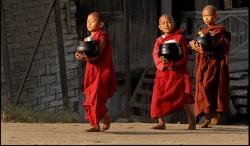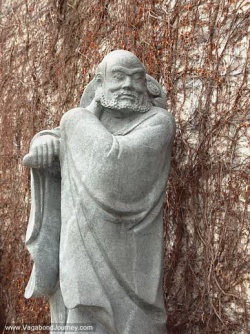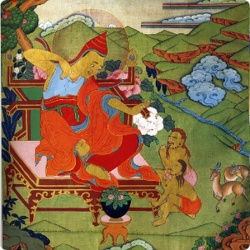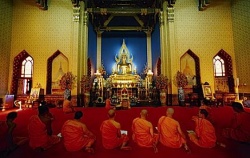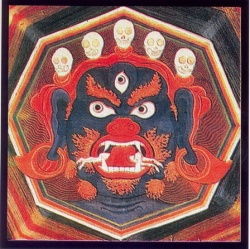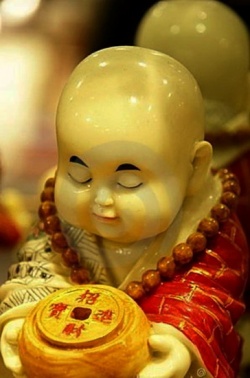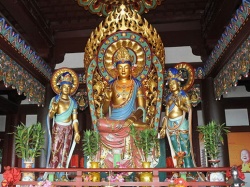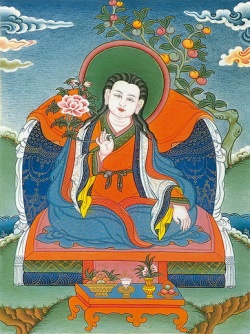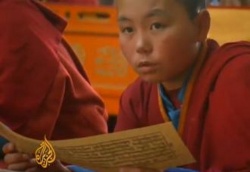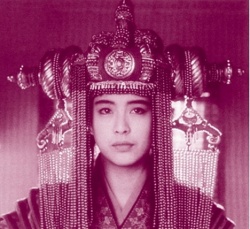What Are the Factors of Sanghikadāna?
“What are the factors of Sanghikadāna, offerings made to the Sangha as a whole?
How are we to perform this type of donation?”
The Dakkhināvibhanga Sutta of the Majjhimanikāya mentions seven types of Sanghikadāna:
Offerings to both Sanghas headed by the Buddha.
After the parinibbāna of the Buddha, offerings to both Sanghas.
Offerings to the Bhikkhu Sangha only.
Offering to the Bhikkhunī Sangha only.
Offerings to selected bhikkhus and bhikkhunīs as the Sangha’s representatives.
Offerings to selected bhikkhus as the Sangha’s representatives.
Offerings to selected bhikkhunīs as the Sangha’s representatives.
When making such offerings, one should focus one’s mind on giving to the Sangha. So the Buddha classified seven kinds of Sangha. This Sanghikadāna brings the greatest benefits for all. Before making the offerings, the donor should meditate on the nine virtues of the Sangha. He or she should banish the idea of personal references or personal attitudes towards any individual monk, regarding the whole Sangha as the recipient.
How is this attitude possible? A donor must not choose individual monks according to personal preference. He or she must suppress any likes and dislikes. The intention to offer to the Sangha must focus on the virtues of the Buddha, Dhamma, and Sangha. Avoiding personal preferences, one should regard any monk as the representative of the Sangha. One should reflect thus: “He is a son of the Buddha, a representative of the Sangha, and therefore represents all the virtues of the Buddha’s first five disciples, the sixty Arahants who were the first missionaries, the one thousand Arahants of the Uruvela Forest, and other Arahants like Venerables Sāriputta, Moggallāna, and Mahākassapa.” Thus the supporter concentrates his mind on the virtues of the whole Sangha and, in this way, donates Sanghikadāna.
The commentary says, “Even in offering to immoral monks who only wear the robes around their necks, if one focuses the mind on the Sangha, it amounts to offering to the eighty great Arahants lead by the Venerables Sāriputta and Moggallāna.” The good results one gets are the same. This is possible because the Noble Sangha, the true sons of the Buddha, by their powerful virtues, permeate influences and honour even today. The offering is beneficial not because of the monks’ immoral nature, but because of the purity of the Sangha.
Thus, a donor must focus his mind on the purity and power of the Buddha’s Noble Sangha. So even when offering to immoral monks, such good influences and benefits prevail if the mind is skilfully directed. So offering robes to immoral monks, amounts to offerings made to Arahants, past and present, who have completely eradicated the defilements. This Dhamma support gives Sanghikadāna the greatest benefits. In offering food, dwellings, etc., the donor must pay regard to the Sangha only. So he becomes a supporter of the Sangha — all the greatest disciples of the Buddha.
In making offerings to the Buddha image, although the Buddha had passed away, the act amounts to the same nature and result. So building Buddha images, pagodas, etc., gives the title “Supporter of the Buddha.” The mind should be directed towards the support and offerings to the Omniscient Buddha himself who has passed away. So the title “Supporter of the Buddha” does not mean the image, but the Buddha himself.
With the devotional mind on the Buddha himself one can now set one’s attitude correctly in making Sanghikadāna even to ordinary monks. For example, take the case of those who have many children. Although some children may die, other children remain, so when the parents die, the remaining children inherit their property. Likewise, all types of monks today inherit the Dhamma nature of the past noble sons of the Buddha. They act as recipients, representatives, and heirs. So in the acts of offering and sharing of merits, one must hold the Sangha in mind and dedicate the offering to the Sangha as a whole (Sanghagatā). The cultivation of this crucial “Sanghagatā citta” is vital. While one invites some monks, and physically offers donations to them, one focuses the mind on the Sangha, which is “Sanghagatā” decision. One must, of course, offer food to a particular monk, but the attitude should be on the Sangha. Present-day monks will use the property or take the food very respectfully if they know that it is Sanghikadana. Improper use makes them serious offenders as it taints the whole Sangha.
The first type, offering to both Sanghas headed by the Buddha, can be attained by offering to the Buddha and his followers by declaring “Buddhappamukhassa ubhatosanghassadema.” The attitude must be correct. Now that the Buddha has attained parinibbāna, to perform this first type of Sanghikadāna, one must place a Buddha’s image containing holy relics, with a begging bowl, in a suitable place. Then after making offerings to the Buddha’s image, food and requisites must be offered to bhikkhus and bhikkhunīs. Images with relics to represent the Buddha are used to maintain the highest honour and respect among the donors. This is a special case. Ordinary Buddha images can take the place of the Buddha though there may be no true relics present. The attitude, if noble, produces the same result.
As regards the second type of Sanghikadāna, the meaning should be clear and no further explanation is necessary.
The third type of Sanghikadāna can be obtained by offerings made in front of a Buddha’s image with holy relics. The procedure is the same.
As regard the offerings for the Bhikkhunī Sangha, today it is impossible as no bhikkhunīs exists.
The above four types of Sanghikadāna are always performed by inviting monks in general for alms. The invitation must be made with the Sangha in mind.
Regarding the fifth, sixth and seventh types of Sanghikadāna, they are classed under the main type called “Uddissaka Sanghikadīna.” The cases are as follows. A donor has insufficient means to feed hundreds of monks in a monastery. Hence he asks the chief monk to send a few monks for his alms-giving in the house. The chief monk then selects representatives of the monastery. The donor must neither choose nor select monks; neither can he name them. The term “Uddissaka — selected”, means selection made by the chief monk to represent the whole Sangha.
In this “Uddissaka Sanghikadāna” if a lay-supporter fails to purify his mind or maintains the wrong attitude many evils arise if he or she thinks in terms of names, status, or persons. In the commentary it is explained thus:
“A person thinks, ‘I will offer Sanghikadāna,’ and makes well-prepared food. Then he goes to the monastery and asks for a monk to receive alms. Choosing by lots, the Sayādaw sends a novice. Seeing this young novice as a recipient the donor is disappointed, as he was expecting a Mahāthera. So his confidence is destroyed by his wrong mental attitude. If his confidence wavers he cannot attain this noblest almsgiving called ‘Sanghikadāna’ even if is pleased at getting a Mahathera. In both cases, due to his wrong attitude, he fails to maintain the idea of ‘Donation to the Sangha,’ which is the noblest intention.” In ancient times, the Sayādaws, due to frequent invitations for Sanghikadāna, prepared a list of monks to be sent by lot, irrespective of age and status.
If a donor asks for an elderly monk, the Sayādaw must not agree with this request. He must send a monk or monks by ballot, selected according to a list already prepared. So one may get a novice although one has asked for a Mahāthera. Anyhow one’s intention of donating to the Sangha must not be shaken, whatever the nature of a monk or a novice may be.
To give Sanghikadāna the donor must cultivate the thought of ‘donation to the Sangha’ to the highest degree. Motive alone counts whatever the situation is. Just as Venerable Sāriputta and Moggallāna, with the eighty great Arahants, are worthy of receiving food and shelter, the present-day Sangha obtains the same privileges due to the power of the Sangha. Even if one gets a novice for offering almsfood, one should keep in mind that the Sangha is the recipient, not the novice. This novice is a means to an end, not the end itself. Considered in this light, one should not have any personal preferences in the matter of Sanghikadāna. Only then is this unique Sanghikadāna attained.
A weak person with a wrong motive will find this type of donation the most difficult thing in the world. He or she fails to maintain the idea of donation to the Sangha when his or her wishes are thwarted. One must not feel either regret or joy in getting a particular monk. With clear intention and firm determination one must not look at “faces” or the “world.” If these disciplines are present then one obtains the rare opportunity of offering “Sanghikadāna.” It is very difficult to perform this kind of meritorious deed, as the mind is tricky.
Even if one gets a young novice or an immoral monk, one must treat him just like one would treat the Venerable Sāriputta or Venerable Moggallāna. The correct attitude must be placed on the Noble Sangha only. So every respect and honour must be paid to him. Any prejudice or partiality must be removed. If complete impartiality is lacking, the donor’s mind fails to focus on the Noble Ones like Venerable Sāriputta. His mind remains with the present young novice or shameless monk to whom he has to offer food. His mind is limited to such a person and the limitless range of mind becomes tainted and its purity destroyed.
In this context, the commentary gives an interesting account from ancient times. Once a rich man, wanting to offer Sanghikadāna for his monastery, asked for a monk from the Sayādaw. Though an immoral monk was sent, he paid respect and honour to this depraved monk and sincerely made offerings to the monastery with his mind fixed on the “Sangha.” He presented ceiling cloths, curtains, and carpets. Then he treated the immoral monk just like one would treat a Buddha. He always paid respects to him. When others blamed him, he replied that although an immoral monk was the recipient, he offered his donation to the Sangha only. He explained that he was not approving of the bad actions of the immoral monk as his mind was fixed on the Noble Sangha. He donated it to the Sangha, though an immoral monk had to accept it. Thus right motive and right understanding amount to “Sanghikadāna” — the greatest donation of all.
In the Tipitaka, it is stated: “If, with a pure, devoted mind, one pays respect to the Noble Sangha even if one offers food to an immoral monk, one is actually offering food to the Buddha. So the act is the noblest one.”
Although it is not mentioned in the question, I give a graded list of persons worthy to receive alms, as given in the text. An animal, an immoral lay person, a moral lay person, hermits with jhāna outside the Buddha’s dispensation, Noble Ones,1 Paccekabuddhas and Omniscient Buddhas — a total of fourteen types of individual. Moral lay persons means those who live outside the Buddha’s dispensation, who are moral. Those with morality in this dispensation are included under those striving to become Noble Ones, in this dispensation.
The commentary states: “A lay person possessing morality is liable to attain Stream-winning if he practises the Noble Path. So he is practising rightly (supatipanno), and worthy of honour and respect. If one offers food to a man professing Three Refuges, with a pure mind, one gets immeasurable benefits due to this qualification. Many powerful benefits arise for him. If one honours a person who keeps five precepts by offering food, this is the best among donation to lay persons, and brings limitless benefits. If a person keeping ten precepts is offered alms, the donor gets even more benefits. As for offerings made to a Stream-winner, this is supreme among donation performed by ordinary persons. The point to note is that those lay persons with five precepts who have confidence in the Three Gems are in line to become Stream-winners. Therefore such a lay person is a well-behaved person worthy of respect and honour.” This is the explanation of the commentary. Following this line of thinking and behaving, one can appreciate the value of donation giving to ordinary monks and novices whatever the state of their morality.
The texts mention that persons outside the Buddha’s dispensation (non-refuge taking persons) can be classified as immoral lay persons, and as moral lay persons. In this respect classes of lay people, novices, and monks inside the dispensation are not mentioned. In the commentary, classification is made for the persons inside the dispensation on similar lines. So it is clear that scrupulous monks and novices are worthy of respect and honour.
However, the question is “Can shameless or immoral novices and monks be classified under the fourteen categories mentioned already?” Teachers hold different opinions. However, in the Milindapañha a sound decision is made when the king asks: “What is the difference in virtue between an immoral layman and an immoral monk?”
“O king, an immoral monk has greater virtues than an immoral layman in ten ways.
They are inconceivable in an immoral layman while an immoral monk possesses them in full.
What are they? An immoral monk possesses ten virtues:
He pays respect to the Omniscient Buddha.
He pays respect to the Dhamma.
He pays respect to the Noble Sangha.
He pays respect to his companions in the holy life.
He hear and learns the Tipitaka and its commentaries.
Although he has broken the rules and lives without morality, when he enters an assembly of monks he instantly takes the sign and behaviour of modest monks.
He guards his deeds and words due to fear of peoples’ criticism and blame.
His mind inclines towards to concentration and insight from the position of a lay disciple. He yearns for the state of a good layman.
He is still classified as monk.
When he does immoral acts he perform them in secret. This means he has shame in his mind.
Not one of these good qualities exists in an immoral layman,
so an immoral monk is more honourable than an immoral layman.”
We have already mentioned the Sinhalese king, Saddhātissa who, could pay respects to a shameless monk due to his insight. He could see the noble quality — fear of criticism and blame — in that shameless monk. That unique quality, as mentioned in the Milindapañha, is the seventh reason that he is worthy of respect. Another virtue he saw in the shameless monk was the tenth one — doing evil deeds furtively due to moral shame and fear. If a person can detect and appreciate at least these two virtues of a shameless monk he is called a wise man. With wisdom he knows the power of these great virtues, even in a bad person.
If an immoral monk still claims to be a monk, in the technical sense he is a monk because unless he relinquishes the robe he cannot be classed as a layman. He is not a novice either. His status remains above the position of a layman or novice. The power of the Vinaya has to be stressed repeatedly, otherwise many will underestimate it.
The questioners ask a supplementary question, “If alms is given to an immoral monk, can it achieve great, beneficial results for the donor?” It should be noted that for a donor, an immoral monk can be worthy of receiving gifts by ten purities known as “Dakkhinavisuddhi”, giving great benefits for benefactors.
An immoral monk wears robes, and carries a begging bowl, which are sacred symbols expressing the determination and intention to destroy defilements.
In the style of hermit and monk he behaves in several ways correctly.
He is still within the protection of the Sangha.
He still retains the Three Refuges.
He still lives in a monastery where concentration and insight are practised diligently.
He seeks refuge in the Sangha.
He practises and teaches the Dhamma to others.
He relies on the Tipitaka as a light of wisdom. His mind is inclined towards the Dhamma.
He believes that the Buddha is the highest and the noblest person in the three worlds.
He observes some Uposatha and ethical precepts.
So these honourable and pure things help a donor to obtain great benefits when gifts are offered to him. Giving alms to him brings immense benefits for a donor, not because of his serious fault, but because of the ten purities. After all, he still retains a monk’s status. If an immoral monk returns to lay life by confession and declaration, he forsakes his monk status and becomes a layman.
Several cases can be cited regarding the importance of a skilful attitude and motive. A laywoman, seeing a very bad monk, failed to show respect and honour to him. She did not offer almsfood as usual. So a teacher instructed her as follows: “Lay disciple, in this encounter with the dispensation your eyes now see a monk. This alone is an auspicious, and rare event. Consider the series of lives in which the dispensation does not exist, where no true monks can be seen with the physical eyes. It is a rare chance you have now having seen a monk in robes, going for almsround. Why create hatred, greed, and delusion at this noble sight, which is a rare opportunity. This “seeing of a monk” is greater merit than achieving kingship, lordship, or rulership. It is greater than the glory and power of Sakka, king of the gods. Even the greatest brahma cannot get this unique opportunity when there is no dispensation. Seeing the “form” and robe of a monk only once has a greater glory and power them seeing Brahma. In this infinite samsara, encounter with the Buddha’s dispensation is very rare. It is an auspicious event just to see a monk.”
Then the teacher asked the laywoman how much the food cost, and how could one estimate the value of seeing the monk’s robe. Even if she had asked for such an encounter by giving one hundred kyats, it is impossible for the monk to come daily. Even hundreds of thousands of kyats could not offer this rare opportunity of seeing the robe. Hence this immoral monk is giving her the greatest benefit by showing the robe before her eyes so that the importance of the Buddha’s dispensation can be realised. The laywoman should therefore show gratitude and honour to the immoral monk. From that day onwards, due to this wise instruction, she devotedly offered almsfood to this monk too. Her confidence became clear and strong. This skilful attitude is mentioned in the Milindapañha as “Anavajjakavacadharanatāyapi dakkhinam visodheti — he helps to purify the gift by wearing the robe of the blameless ones.”
Another case stresses the fact that even seeing the monk’s robes is a rare good chance. One day a hunter saw a monk’s robe in a grove. Since a monk’s robe is a symbol of Arahantship, he felt great joy, inspiration, and reverence, so he worshipped it. After his death, he was reborn in a celestial realm due to this merit. This meritorious act, with right contemplation, is called “Cīvarapūja”, reverence for the robe. It also means “paying honour to those worthy of honour.” This deity became a human being during the time of the Buddha, entered the Sangha, and attained Arahantship.
Among the ten virtues of an immoral monk, some create suffering and grave dangers for a wayward monk if he does not immediately return to lay life. However, for a clear-sighted lay person, who makes skilful donation with the purity of the giver, all ten virtues become causes for meritorious thoughts, speech, and deeds. For ignorant and uncultured lay persons, these ten virtues in an immoral monk become causes for demeritorious thoughts, words, and deeds repeatedly.
A question may be asked, “Why does the Buddha teach us that if alms are given to an immoral monk, only small benefits can be achieved?” In teaching the fourteen grades of persons, the progressive beneficial results are clear. A scrupulous monk is just like good soil. This can be seen by studying numerous stories in the Dhammapada. It clearly shows that less benefits result from offering alms to an immoral monk. Much greater benefit accrues from giving alms to a scrupulous monk.
Anyhow, one must use clear-sighted evaluation, seeking or regarding all aspects in performing charity. The Buddha gives many guidelines for different situations and conditions that might face a donor. In the Dakkhināvibhanga Sutta (M. iii. 253), fourteen grades of alms recipients are enumerated. First giving food and shelter to animals brings benefits of one hundred times. Giving alms to an immoral person brings benefits a thousand times. Giving alms to a moral person brings benefits a hundred thousand times. Giving alms to a non-Buddhist who is free from lust [through attaining jhana] brings benefits millions of times. The benefits from giving alms to a well-behaved person who is striving for the attainment of Stream-winning are immeasurable, so what can be said of giving alms to a Stream-winner? Then one gets even greater benefits from giving alms to one striving for Once-returning, a Once-returner, one striving for Non-returning, a Non-returner, one striving for Arahantship, an Arahant, a Paccekabuddha, and an Omniscient Buddha. Thus giving alms to the Buddha achieves the greatest immeasurable benefits.
Regarding immeasurable benefits, the term “immeasurable” has a range of meanings. The grains of sand in one town are immeasurable. The grains of sand in the world are also immeasurable. So the term “immeasurable benefits” has a wide range of meanings.
In the progressive list of fourteen types of recipients, gifts offered to each type have less benefit than the next. The results depend on the virtue of the recipient. Compared with the results of giving alms to a shameless person, giving to a scrupulous person produces more benefit. So persons of the highest moral conduct will provide the donor with the highest benefits. Gifts to the Omniscient Buddha give the best results of all. Comparisons should be made according to the virtue and wisdom possessed by recipients. Today the chance of offering almsfood to Noble Ones is very rare. The chance to offer alms to ordinary monks is relatively common. Given the present situation, offering of alms to ordinary scrupulous monks must be regarded as almsgiving with great fruit and benefit. This is the rational and practical way to classify persons today.
The above is a general remark only. The Arahant is highly praised by the Buddha. Only the best moral monk, the Arahant, gives the best results. So in this context an ordinary scrupulous monk cannot produce both great results and great benefits. Only giving alms to Arahants produces these two features. Hence the words of the Buddha must be interpreted according to their context.
Which is the Best Offering?
Among two types of offering, which one is more beneficial — feeding a monk sent by the Sangha for Sanghikadāna or feeding the Omniscient Buddha personally?
In the Dakkhināvibhanga Sutta the Buddha says, “Na tvevāham Ānanda kenaci pariyāyena sanghagatāya dakkhināya pātipuggalikam dānam mahapphalataram vadāmi. — In no way, Ananda, does a gift to an individual ever have greater fruit than an offering to the Sangha.”
The Buddha spoke in the clearest terms. Therefore we cannot say that alms given personally to the Buddha is superior to Sanghikadāna.
In the commentary too it is explained: “Sanghe cittīkāram kātum sakkontassa hi khīnāsave dinnadānato uddisitvā gahite dussīlepi dinnam mahapphalatarameva. — With one’s mind respecting the Sangha it is possible to get more benefit from alms offered to the Sangha, even if the monk is immoral, than giving alms to an Arahant as an individual.” Thus the commentary is definite on this crucial point in agreement with the Sutta. These words are also clear.
In the Pāli text too, the Buddha tells his step-mother, “Sanghe Gotamī dehi. Sanghe te dinne ahañceva pūjito bhavissāmi sangho ca. — Give it [the robe] to the Sangha, Gotamī. When you give it to the Sangha, the offering will be made both to me and to the Sangha.” It is also clear here that the Buddha’s instruction is to prefer Sanghikadāna to donations to individuals.
When his step-mother offered two sets of robes, the Buddha accepted only one set. Then he uttered the famous words just quoted. Why did he urge Gotamī to offer robes to the Sangha saying it has greater benefits? In the past, disputants created a controversy from this by saying that alms offered to the Buddha is inferior, so for greater results he made this instruction.
In the commentary to the Dakkhināvibhanga Sutta the disputants’ view is rejected.
“Nayimasmim loke parasmim vā pana,
Buddhena settho sadiso va vijjati.
Yamāhuneyyānamaggatam gato.
Puññatthikānam vipulaphalesinan’ti.
Vacanato hi satthārā uttaritaro dakkhineyyo nāma natthi. Evamāssā cha cetanā ekato hutvā dīgharattam hitāya sukhāya bhavissanti’ti dāpesi.”
The meaning is that the Buddha’s instruction to Gotamī in this case was not because Sanghikadāna is superior even to donation to the Buddha. This is not the meaning. As a recipient of donations no one is greater than the Buddha himself. Therefore the Buddha’s aim is as follows: If Gotamī offers the robes to the Sangha she will obtain the effects of three good intentions of making donation again (before, during, and after) after he accepts the first donation, which promotes three good intentions for her. So there are six good intentions in the two acts of donation, which give Gotamī countless blessings and beneficial results bringing her peace and happiness for a long time. With this aim he instructed Gotamī to offer the remaining set of robes to the Sangha, praising the benefits of Sanghikadāna.
Then it may be asked, “Does the above explanation contradict the discourse already quoted?” There is no contradiction. Among the various donations to individuals, exception must be made in the case of donations to the Buddha. So it is not contradictory.
Another method of explanation may he given here. The reason is this. Since Gotamī will certainly attain parinibbāna as an Arahant bhikkhunī, this robe-offering has no further effects for her. One set of robes is sufficient for the Buddha and the second set is unnecessary for him, but the Buddha has no personal preferences for any individual monk. Therefore he instructs Gotamī to offer them to the Sangha. The aim is to protect and develop selflessness and to let the power of the Sangha be known.
Anyhow this explanation may not fully satisfy the requirements of the question. Then a good, reasonable answer may be given to make a definite decision. The question is, “Is individual donation to the Buddha superior to the seven types of Sanghikadāna?
The Buddha’s teaching: “In no way, Ānanda, does a gift to an individual ever have greater fruit than an offering to the Sangha.” is clear, and no controversy should arise. The question should not be asked at all because it is not suitable to declare that any one of the seven types of Sanghikadāna, is superior to individual donation. It is unsuitable to answer because an individual recipient cannot be said definitely to be superior. Considering all these facts, the Commentary’s explanation is correct, which correctly explains the Pali text.
Here I present some cases for thoughtful persons to consider. When donors were offering food to the Buddha, they saw him in person. After he attained parinibbāna, many devotees made offerings to Buddha images as individual donation to the Buddha. Is this merit greater than Sanghikadāna now? The next problem to consider is: “Which is greater merit? Building pagodas or Buddha images, and offering food to them as individual donation, or Sanghikadāna such as offering a monastery to the Sangha? These problems are offered for consideration because in the Vimānavatthu it says: “Titthante nibbute cāpi, same citte samam phalam. Cetopanidhihetu hi, sattā gacchanti suggatim — whether one actually sees the Buddha in person or not, if the mind is fixed on him, it has the same effect as the intention is the same. Many beings go to celestial realms because of this correct attitude, although they do not actually see him.” Only mind can help one to achieve heavenly attainment and nibbāna. If the motive is the same, the effects are the same. Confidence can be present in Buddha’s presence or in Buddha’s absence.
However, to have equal confidence in both cases is very unlikely. If one sees the Buddha in person, one’s confidence may be much greater than in seeing a Buddha image. How wide this gap will be is hard to decide. To what extent can a mental object give rise to confidence? Wise persons should consider these problems.
Notes
There are four types of Noble Ones who have attained the four paths, and four types striving for the four paths — eight in all. (ed.)
Source
Ledi Sayādaw
Dhamma Dīpanī: A Manual of the Dhamma
Translated by U Han Htay
scribd.com


